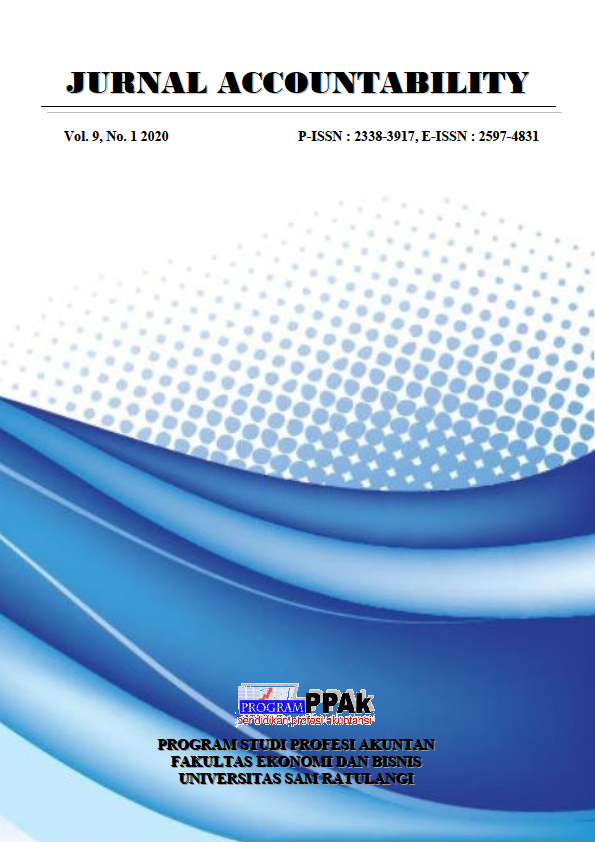FACTORS AFFECTING THE USE OF E-MONEY (STUDY ON E-MONEY USER IN CITY OF SOUTH TANGERANG)
Keywords:
Perceived Benefit, Compatibility, Perceived Usefullness, E-moneyAbstract
The purpose of this study is to analyze the factors that influence the use of e-money. The type of study is a quantitative method questionnaires distributed in soft copy (Google Form). The samples included 107 people who lived in the city of South Tangerang, Banten. Samples are taken by simple random sampling technique. The analytical method used is the analysis of multiple data processing using E-Views 8. The results of this experiment show that the variables of Perceived Benefit and Compatibility does not affect the use of e-money, while Perceived Usefulness variables influence the use of e-money and also, Perceived of Benefit, Compatibility and Perceived Usefulness affect on the use of e-money together.
References
Adityawarman. (2014). Jasa Marga kesulitan siapkan uang kembalian. https://ekbis.sindonews.com/berita/843175/34/jasa-marga-kesulitan-siapkan-uang-kembalian
Anjelina. (2018). Persepsikonsumen pada penggunaan e-money. Journal of Applied Managerial Accounting, 2(2), 219-231. https://doi.org/10.30871/jama.v2i2.934
Davis, F. D. (1989). Perceived usefulness, perceived ease of use, and user acceptance of information technology. MIS Quarterly, 13(3), 319-340. https://doi.org/10.2307/249008
Filona & Misdiyono. (2019). Factors affecting the adoption of electronic money using Technology Acceptance Model and Theory of Planned Behavior. Jurnal Ilmiah Ekonomi Bisnis, 24(1), 108-120. http://dx.doi.org/10.35760/eb.2019.v24i1.1858
Hoffmann, V. (2011). Knowledge and innovation management: Module Reader. https://www.researchgate.net/publication/225616414_Farmers_and_researchers_How_can_collaborative_advantages_be_created_in_participatory_research_and_technology_development
https://www.bi.go.id/id/ruang-media/siaran-pers/Pages/sp_82606.aspx
https://www.bi.go.id/id/sistem-pembayaran/di-indonesia/Contents/Default.aspx
Ma’ruf, A. (2016). Minat penggunaan produk e-money di kalangan mahasiswaYogyakarta: Analisis faktor pengaruh berdasarkan perspektif TAM dan TPB. Skripsi. Universitas Islam Negeri Sunan Kalijaga. http://digilib.uin-suka.ac.id/24169/
Miliani, L., Purwanegara, M. S., & Indriani, M. T. D. (2013). Adoption behavior of e-money usage. Information Management and Business Review, 5(7), 369-378. https://doi.org/10.22610/imbr.v5i7.1064
Lee, M. (2009). Factors influencing the adoption of internet banking: An integration of TAM and TPB with perceived risk and perceived benefit. Electronic Commerce Research and Applications, 8(3), 130–141. https://doi.org/10.1016/j.elerap.2008.11.006
Lintangsari, N., Hidayati, N., Purnamasari, Y., Carolina, H., & Ramadhan, W. (2018). Analisis pengaruh instrumen pembayaran non-tunai terhadap stabilitas sistem keuangan di Indonesia. Jurnal Dinamika Ekonomi Pembangunan, 1(1), 47-62. https://doi.org/10.14710/jdep.1.1.47-62
Lui, H. & Jamieson, R. (2003). TriTAM: A model for integrating trust and risk perceptions in business-to-consumer electronics. The 16th Bled Electronic Commerce Conference. https://www.researchgate.net/publication/228918781_TriTAM_A_model_for_integrating_trust_and_risk_perceptions_in_business-to-consumer_electronics
Oliveira, T., Thomas, M., Baptista, G., & Campos, F. (2016). Mobile payment: Understanding the determinants of customer adoption and intention to recommend the technology. Computers in Human Behavior, 61, 404-414. https://doi.org/10.1016/j.chb.2016.03.030
Popovska-Kamnar, N. (2014). The use of electronic money and itsimpact on monetary policy. Journal of Contemporary Economic and Business Issues, 1(2), 79-92. https://www.econstor.eu/bitstream/10419/147460/1/86795244X.pdf
Saraswati, N., & Mukhlis, I. (2018). The influence of debit card, credit card, and e-money transactions toward currency demand in Indonesia. Quantitative Economics Research, 1(2), 87-94. http://journal2.um.ac.id/index.php/qer/article/view/3487
Sekaran, U. (2003). Research methods for business: A skill-building approach, 14th Edition. New York: John Wiley and Sons Inc.
Sugiyono. (2014). Metode penelitian pendidikan pendekatan kuantitatif, kualitatif dan R&D. Bandung: Alfabeta.
Wulandari, D., Soseco, T., & Narmaditya, B. S. (2016). Analysis of the use of electronic money in efforts to support the less cash society. International Finance and Banking, 3(1), 1-10. https://doi.org/10.5296/ifb.v3i1.8802
Yulianto, Y., Ferdinand, A., & Soesanto, H. (2016). Studi mengenai pengaruh tekanan waktu untuk membeli, derajat diferensiasi produk dan customer value terhadap minat bertransaksi ulang menggunakan uang elektronik (Studi pada pengguna uang elektronik e-money di Kota Semarang). Jurnal Sains Pemasaran Indonesia (Indonesian Journal of Marketing Science), 15(3), 152-167. https://ejournal.undip.ac.id/index.php/jspi/article/view/14243
Downloads
Additional Files
Published
Issue
Section
License
The articles published in Jurnal Accountability are licensed under Creative Commons Attribution-NonCommercial 4.0 International with authors as copyright holders.
Â

This work is licensed under a Creative Commons Attribution-NonCommercial 4.0 International License.
Â
- Share — copy and redistribute the material in any medium or format.
- Adapt — remix, transform, and build upon the material.
- The licensor cannot revoke these freedoms as long as you follow the license terms.
- Attribution — You must give appropriate credit, provide a link to the license, and indicate if changes were made. You may do so in any reasonable manner, but not in any way that suggests the licensor endorses you or your use.
- NonCommercial — You may not use the material for commercial purposes.
- No additional restrictions — You may not apply legal terms or technological measures that legally restrict others from doing anything the license permits.
- You do not have to comply with the license for elements of the material in the public domain or where your use is permitted by an applicable exception or limitation.
- No warranties are given. The license may not give you all of the permissions necessary for your intended use. For example, other rights such as publicity, privacy, or moral rights may limit how you use the material.


